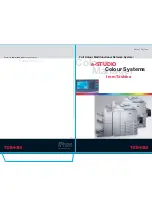
Crestron
e-Control
®
Software
Each cable cannot exceed 328 feet in length. When viewed from
above, a 10BaseT network forms a star configuration. That is,
the cables from all of the devices converge at a common point.
As shown in the figure, three computers are connected with
10BaseT cabling and a hub.
A 10BaseT hub is simply a box with a row of 10BaseT jacks.
Most hubs have five, eight, 12, or 16 jacks, but some may have
more. Most hubs also have an
uplink port
, which is a special
port that allows the hub to be connected to other hubs. Uplink ports are the reverse of
the other regular ports on the hub or switch. This is useful for "daisy-chaining"
network connection devices so you can add ports.
To connect two 5-port switches together, for instance, you could connect one end of a
straight-through cable to the uplink port on the back of the first switch, and connect
the other end of the cable to any available
regular
port on the second switch. This
would effectively add four more ports to the network.
A hub differs from a switch in that hubs use
shared bandwidth
, meaning that they
must share their speed across the total number of ports on the device. As an example,
a 10Mbps 5-port hub shares its 10Mbps speed across the five ports. Thus, if five
devices are connected to five ports, each port can only transfer data at a rate of
2Mbps, because 10 divided by 5 equals 2. A 100Mbps 10-port hub with 10 devices
connected to it shares the 100Mbps across the 10 ports, for a speed of 10Mbps per
port. In addition, the duplex type of the device contributes to the total throughput of
the device.
Switches, on the other hand, use
dedicated bandwidth
. Each port on a switch is
given the full speed of the switch. Therefore, a 100Mbps 5-port switch with five
devices attached would transfer data at 100Mbps over every port — an obvious
advantage over a hub. Switches are usually more expensive than hubs, but the
performance is better. Duplex is a factor in total performance as well.
10/100 Ethernet Cabling Distances
Connection
Speed
Maximum Distance
Hub to Hub (without a switch)
10Mbps
100 meters/328 feet
Hub to Hub (without a switch)
100Mbps
10 meters/32.8 feet
Hub to Switch
100Mbps
100 meters/328 feet
PC to Hub/Switch
100Mbps
100 meters/328 feet
Crestron Control System to Hub/Switch (2-Series and X-Series) 10Mbps
100 meters/328 feet
Crestron Control System to Hub/Switch (2-Series only)
100Mbps
100 meters/328 feet
Crestron touchpanel to Hub/Switch (TPS-ENET only)
10Mbps
100 meters/328 feet
Crestron touchpanel to Hub/Switch (TPS-ENET only)
100Mbps
100 meters/328 feet
Crestron CEN device to Hub/Switch
10Mbps
100 meters/328 feet
Reference Guide – DOC. 6052
Crestron e-Control®
•
5
Содержание e-Control
Страница 1: ...Crestron e Control Reference Guide...
Страница 62: ...Software Crestron e Control 58 Crestron e Control Reference Guide DOC 6052...
Страница 63: ...Crestron e Control Software Reference Guide DOC 6052 Crestron e Control 59...
Страница 71: ...Crestron e Control Software This page intentionally left blank Reference Guide DOC 6052 Crestron e Control 67...
Страница 72: ......
Страница 73: ...Crestron e Control Software This page intentionally left blank Reference Guide DOC 6052 Crestron e Control 69...










































